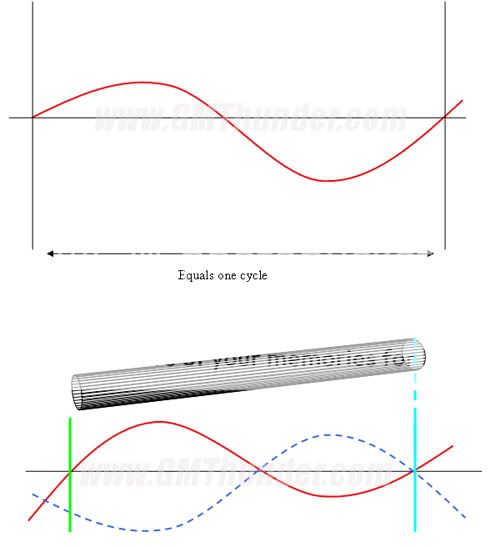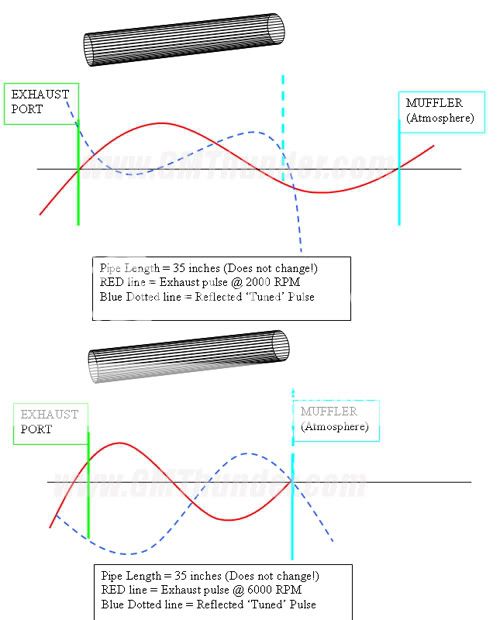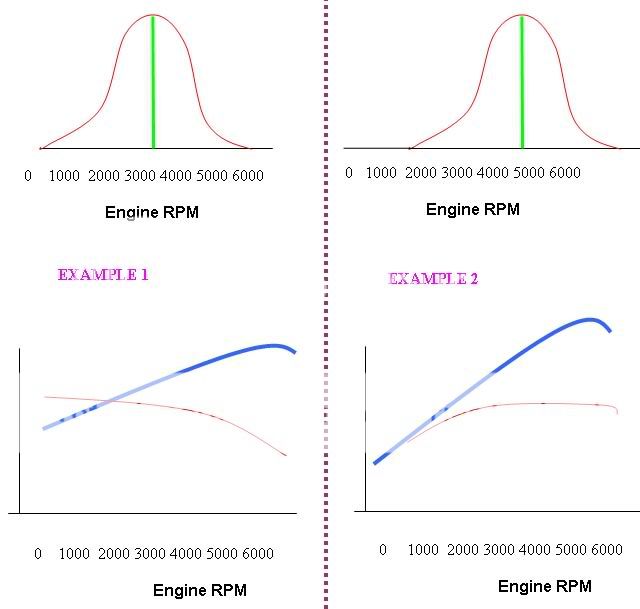Free Flowing Exhaust: Unrestricted flow means unrestricted power.
Cut-outs: Unrestricted flow, but tuned length has changed = power band shifts (depending on length and diameter of pipe). This causes the "loss of low end torque" feeling.
Those examples above are two different tuning methods, and WILL effect torque.
Let's talk about engine mechanics first.
We have a camshaft which is GEARED to the crankshaft. There are VALVE EVENTS which occur at specified
degrees in relation to the crank position.
If you look at a cam card, you will see notes like:
EVO, EVC, IVO, IVC (etc.)
EVO = Exhaust Valve Open
EVC = Exhast Valve Close
You need to understand that these points NEVER
change no matter how fast the engine spins. You also need to realize that the exhaust pipes and headers CAN NOT change length as engine RPM changes (obviously).
This means that your INTAKE and EXHAUST pipes are
TUNED for ONE specific RPM.
RPM changes which also changes the WAVELENGTH of
the PRESSURE PULSE.
Understand that an engine spinning at 1000 RPM
creates LESS pressure pulses than an engine spinning
at 6000 RPM.
Also understand at higher RPM these pulses must
happen FASTER in the same RELATIVE TIME (IE: PER MINUTE)
So...1000 pulses per minute have MORE TIME to happen than 6000 pulses per minute.
This means that higher RPM pulses have a SHORTER
wavelength (pulse length).
Anybody here with a basic understanding of audio
can relate short wavelength of high frequencies of a tweeter to long wavelength frequencies of bass tones of a sub woofer.
Think about your exhaust system. You are on the
DYNO and holding the engine at 2000 RPM.
The exhaust length is 65 inches and let's pretend
the pulse length is 65 inches.
In the diagram below you have a RED line which
indicates the pressure pulse as it EXITS the exhaust
port and travels the length of the exhaust pipe. When the pulse reaches the end of the pipe, it meets the atmosphere. When a moving object HITS another object there is a transfer of energy.
Think of a wave of WATER hitting a wall and bouncing
backward - air moves in a similar fashion. When the exhaust pulse hits the atmosphere it will reflect back toward the exhaust port. The dotted blue line represents this reflected wave - notice that the blue dotted line crosses the black line at, or below the axis.
This means the reflected pulse has reached the
exhaust port with LOWER PRESSURE.
Question One:
Will having a low pressure pulse reflect back
IMPROVE, or HURT the next exhaust pulse exiting?

Those who guessed that LOW PRESSURE will IMPROVE
the flow of the next pulse are CORRECT.
Here's why:
If you were water, or air exiting this exhaust pipe, would you find it easier to exit if there was a valley, or a hill?
The valley is the top scenario.
The hill is the bottom scenario.
Think of low pressure as a WEAK force. `Low` meaning
low force, or low resistance. When the exhaust valve is opening and the piston is pushing the waste out of the cylinder, the exiting pulse is HIGH pressure.
The exhaust gas will exit easier if there is little resistance
at the exhaust port. You can also think of low pressure as a VACUUM. It actually creates a sucking effect at the exhaust port so that when the valve opens, the low pressure area sucks the gas out of the cylinder.
Remember...fluids and gasses move from high pressure
to low pressure - that's a key point here.
So the reflected pulse is tuned to reach the port at LOW
pressure.
Now, what happens when you open your cut-out at 2000 RPM?
Have a look at the next diagram. Notice the top drawing has Engine RPM at 2000 RPM. The bottom has Engine RPM at 6000 RPM.

Think about what happens to the `EFFECTIVE LENGTH`
of your exhaust.
Things to think about:
Is the pipe tuned for a higher, or lower pulse now? The long RED wavelength is the exhaust pressure pulse @ 2000 RPM.
Question 3: At 6000 RPM with a shorter exhaust
pipe, (or cut-out open), will the torque be higher, or lower?
When you're talking about cutouts the distance is CRITICAL and will tune the exhaust to be efficient at ONE
RPM, with a tapering curve above and below that RPM. The RED wave in the top example extends beyond
the length of the pipe.
The WAVELENGTH/PRESSURE PULSE length at 2000 RPM
is LONGER than the TUNED LENGTH of the exhaust
pipe.
Now when you open the cut-out at 2000-3500 RPM
on the street, you notice a lack of POWER. People say "I lost BACKPRESSURE...That's Why I lost power!"
That is not true. By opening the cut out, you
have changed the tuning of the exhaust for the
RPM range you are using. Think about a pipe organ. Wonder why each note on the pipe organ has a DIFFERENT LENGTH of pipe?
"But why does the frequency of the exhaust decide how much power u make?"
It does not decide how much, but when the power
comes in. The pipe length in the exhaust has everything to do with how much power is made.
If you read up a few paragraphs you will see talk of
reflected pulses and exhaust pressure.
At 2000 RPM an exhaust pulse is 50 inches (for example). If we cut a pipe to be "resonant" at 2000 RPM, it would need to be 50 inches. This pipe would only be resonant at ONE RPM, and ONE frequency. The reflected pulse at 2000 RPM will reach the exhaust port and create a LOW PRESSURE area.
While the valves are opening and closing, the pulse
is reflecting back at 2000 RPM, everything is tuned
and resonant...which means it is highly efficient.
Someone driving around in the city would tune their
exhaust to this length because it would be more
efficient from 1000 to 3000 RPM with a PEAK at
around 2000 RPM (or somewhere in the middle).
When this guy goes racing, he opens his cut out. But today, he wants to open the cut out and drive around town. The pipe is now cut smaller in length. The tuned length is somewhere in the 5000 RPM range.
While he drives around at 2000 RPM, the exhaust
pressure pulses are still going to have a 50 inch
wavelength...but... The cut-out does not allow the reflected pulse to come back 180 degrees out of phase.
The reflected pulse returns at a higher pressure
at the port.
Check out this diagram:

Notice the top section on the left and right side.
There is a hump with a green line highlighting the
highest point of the hump. Also notice the RPM
at where the peak of the hump occurs.
Directly below each is a simulated torque and horsepower graph. Which side represents a tuned exhaust for a SHORT PIPE, or CUT OUT?
Answer: Example two!
Just remember it's not BACKPRESSURE that is causing the torque loss, it's all about the tuning - you need to select a pipe length that provides the best power curve in a window of RPM that the car requires.
Just like above, if you're going to be racing,
place the cut-out in a spot that improves the
resonant RPM to around 5000 RPM (like the right
side). On a Thirdgen Camaro/Firebird this would be right around the catalytic converter area.
Then everything above and below 5000 RPM will
taper off within your shift window (4000-6000 RPM).
Harrah's Cherokee Casino Resort selects Harrah's Cherokee
ReplyDeleteHarrah's Cherokee Casino 김포 출장마사지 Resort 통영 출장샵 selects Harrah's 청주 출장안마 Cherokee Casino Resort 목포 출장샵 to 구미 출장샵 feature world-class gaming, dining and entertainment at Harrah's Cherokee